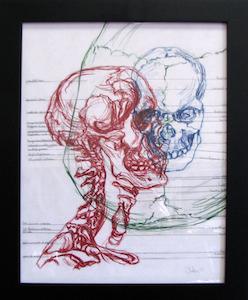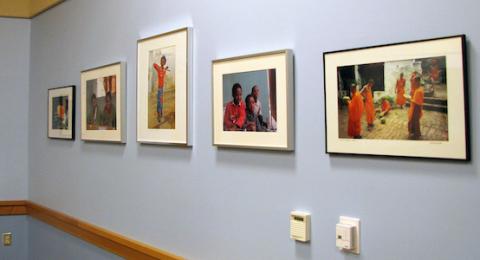
A Collection of Art

The Tower room on the third floor has a wonderful collection of photography donated by former Strauss Health Sciences Library Director, Jerry Perry, Carl Bartecchi, MD, and Janet Lee.
Located on the Third Floor in the Tower Room in the Strauss Health Sciences Library.
A Thousand Paper Cranes
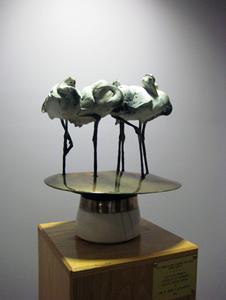
This sculpture was created in 1987 and donated in 1991 by Eloise and Gus Garcia, M.D. The symbolism of Paper Cranes calls on Japanese tradition, which relates that the folding of one thousand origami paper cranes will help to make a wish come true. The creator of this piece goes by one name - "Chapel"
Located on the Third Floor near the South alcove in the Strauss Health Sciences Library.
Columbine

Jim Childress is the design architect from Centerbrook partners in Centerbrook, Connecticut. The design of the library as well as the Columbine motif used for the lights and the ceiling treatment in the Tower Room are attributed to Childress.
Located on the First Floor on the Access Services desk in the Strauss Health Sciences Library.
Constructure
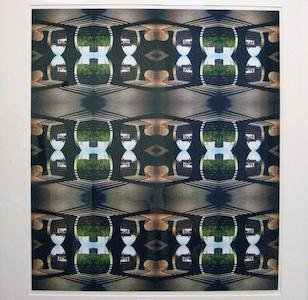
Constructure #1- Ron Landucci, Infinite Editions, Inc., color pigment print on canvas.
Located on the First Floor near the West wall in the Strauss Health Sciences Library.
Denison Stained Glass Window
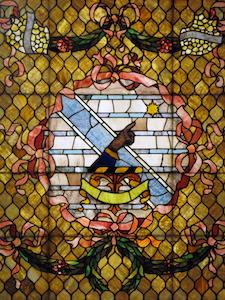
The stained glass window, with the Denison family coat-of-arms, was donated to Denison Memorial Library in 1949. It was originally located at a former residence of Charles Denison, M.D. on 1625 Logan Street in Denver.
Located on the Second Floor past the South elevator in the Strauss Health Sciences Library.
Doves and Stained Glass
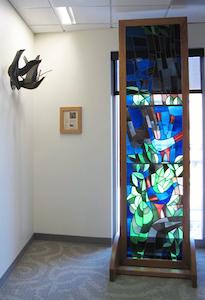
Formally known as Doves, the wall hanging was crafted by Edgar Britton and has the artist’s signature “EB” at the base’s lower right. The framed stained glass panel is 8.25 feet by 2 feet and is a colorful, angular and abstract design of birds walking. The stained glass panel bears the artist’s signature “EB.”
Located on the Third Floor next to the Tower Room in the Strauss Health Sciences Library.
Edgar Britton
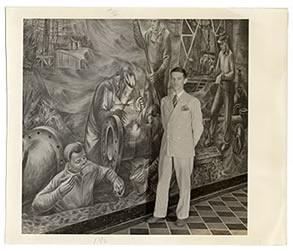
A Nebraska native, born in Kearney in 1901, Edgar Britton became one of the most prominent, prolific, and important artists of Colorado where he died in Denver in 1982. When diagnosed with tuberculosis in 1941, and on the advice of his physician, Mr. Britton relocated his well-established and successful art career from the Midwest to the foothills of Colorado.
Family Doctor
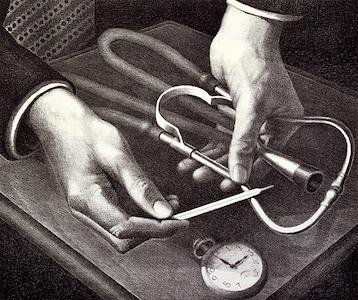
Printed in 1940, the lithograph is part of an edition of 300, and was the cover art for the September 2, 1998 issue of JAMA. Family Doctor is a gift of Gus Garcia, M.D.
Click here to read more about Grant Wood.
Located in the Amesse Collection on the east side of the First Floor in the Strauss Health Sciences Library.
Freedom
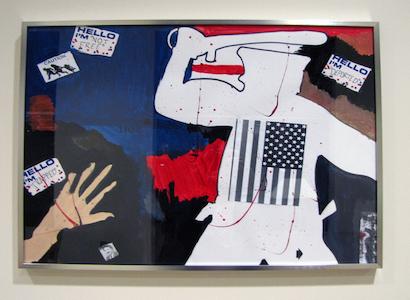
Students and Teachers Art Exhibit with the Aurora Public Schools K-12
Located on the First Floor near the West wall in the Strauss Health Sciences Library.
Humanescence
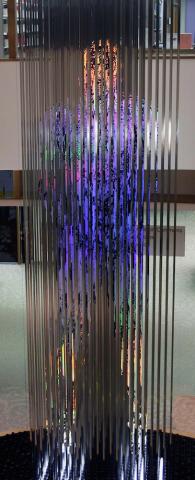
Douglass' sculpture features hundreds of thin stainless steel tapes suspended from floor to ceiling and set in a lighted mounting. Imprinted on the individual strands of tape are sectional images from the Visible Human's male subject such that, when viewed in composite, the entire body is revealed, suspended in mid-air.
Learn more about Rae Douglass and his work.
Click here to view the Youtube video of the sculpture construction.
Production: Chad Oelke and Ian Nitta
Located on the First Floor near the Access Services desk in the Strauss Health Sciences Library.
Lifelines

The large diptych titled Lifelines is acrylic on canvas with several layers of acrylic gloss varnish. Click here to read more about Sue Simon.
Located on the Third Floor near the Tower Room in the Strauss Health Sciences Library.
Microscopic Universe

The set of five acrylic prints entitled Microscopic Universe are monotypes. A monotype is a kind of print with an edition of one. Acrylic paint was applied to a piece of glass and a damp sheet of print paper was carefully laid on top of the glass. The back of the paper was rubbed to pick-up the paint on the glass. When the paper is peeled off the glass the result is a monotype. In the case of the Microscopic Universe monotypes, Simon used other pieces of monotype as collage and added scientific drawings in ink. All of the works were commissioned by the University of Colorado Denver at Anschutz Medical Campus.
Located on the Third Floor near the West wall in the Strauss Health Sciences Library.
Muscle Diagrams

The muscle diagrams are for the most part redrawn from Textbook of Anatomy, edited by Frederic Henry Gerrish, and published by Lea Brothers in 1902. The innervation charts were compiled from the standard textbooks of anatomy. These charts and diagrams are found to be particularly useful for kinesiology classes and for physical therapy technicians.
Located on the First Floor at the North end of the library in the Strauss Health Sciences Library.
Night Baseball
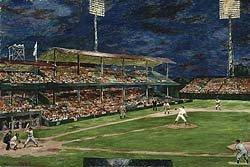
Marjorie Phillips was the wife of Duncan Phillips, of The Phillips Collection in Washington D.C. Marjorie was both an artist and a partner to her husband in the development of The Phillips Collection. Her works were exhibited both at the Phillips and in other galleries. She was most identified with her painting Night Baseball, which depicts Joe DiMaggio at bat against the Washington Senators in 1951. Accustomed to day games, she later wrote she was "thrilled" by the changing colors of the night sky. Night Baseball became something of an icon in the city after the Senators left in 1971. "They can take away the team," wrote the Washington Post in 1985, "but they haven't been able to take away the painting."
The print, Night Baseball, was purchased and donated by Jerry Perry, former Health Sciences Library Director.
Located on the west side of the Third Floor in the Strauss Health Sciences Library.
Tenmile Range Clouds

John Fielder's work was exhibited in the Library Gallery during Spring and Summer of 2008. Fielder is renowned for his awe-inspiring photographs of Colorado landscapes. This particular image was taken at Tenmile Range near Breckenridge, Colorado, and was purchased by Jerry Perry, the former Health Sciences Library Director, and donated to the Library.
Click here to see more of John Fielder’s work.
Located in the Study Zone on the Second Floor in the Strauss Health Sciences Library.
The Foot and The Hand
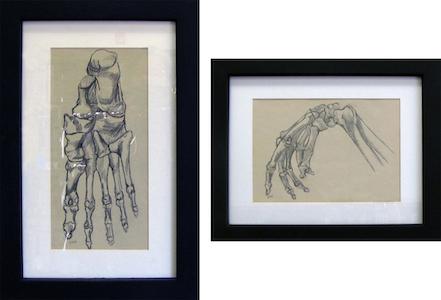
Located on the First Floor in the Amesse Collection in the Strauss Health Sciences Library.
Totem - Red, Yellow, Blue #2, 2007
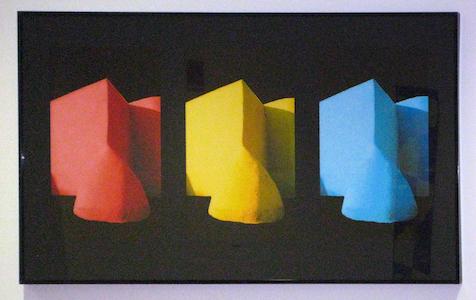
Ginny Shipman, Digital Collaborator
Original photo is San Francisco de Asis Mission Church in Ranchos de Taos, NM.
Totem: An object, often an animal, a plant or a special object, serving as an emblem of a clan or family. A totem may be a reminder of ancestry, becoming an embodiment of a spirit and taking on a life of its own.
Located on the North end of the Third Floor near the Library Gallery in the Strauss Health Sciences Library.
Totem - Yellow Triptych, 2007
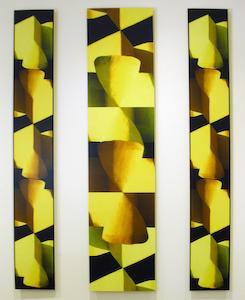
Ginny Shipman, Digital Collaborator
Original photo is San Francisco de Asis Mission Church in Ranchos de Taos, NM.
Totem: An object, often an animal, a plant or a special object, serving as an emblem of a clan or family. A totem may be a reminder of ancestry, becoming an embodiment of a spirit and taking on a life of its own.
Located on the North end of the Third Floor near the Library Gallery in the Strauss Health Sciences Library.
Witness to the Holocaust
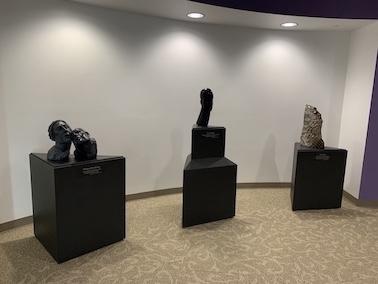
Witness to the Holocaust is a set of six sculptures created by artist Devorah Sperber. The sculpture series represents the process through which the artist came to terms with her family’s history during World War II, and her questioning of what it means to be a second generation survivor. The sculpture series traveled with the Anne Frank Exhibition for over 25 years before arriving at the Strauss Health Sciences Library in 2018 as a gift from Hannah Sperber, the mother of the artist.
The bronze castings were patinaed to retain the natural qualities found in the original stone sculptures from which they were cast. The sculptures are accompanied by selected quotes from The Diary of Anne Frank. The library displays the sculptures in collaboration with the Holocaust, Genocide and Contemporary Bioethics Program at the Center for Bioethics and Humanities. Find more information about the sculpture series and the Center for Bioethics and Humanities here.

